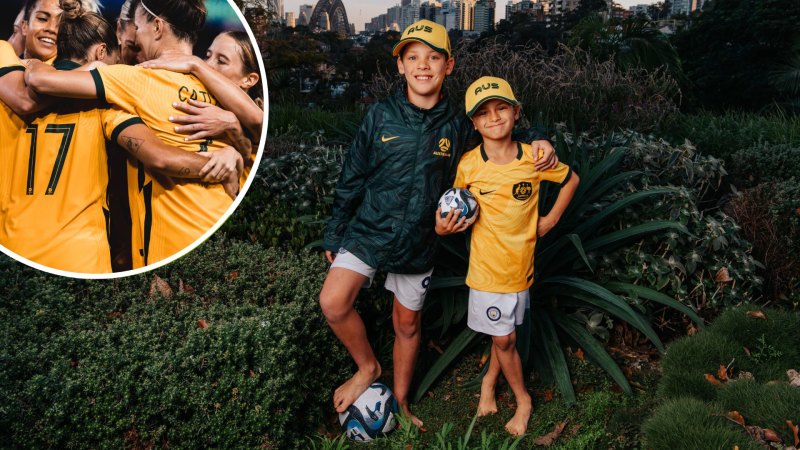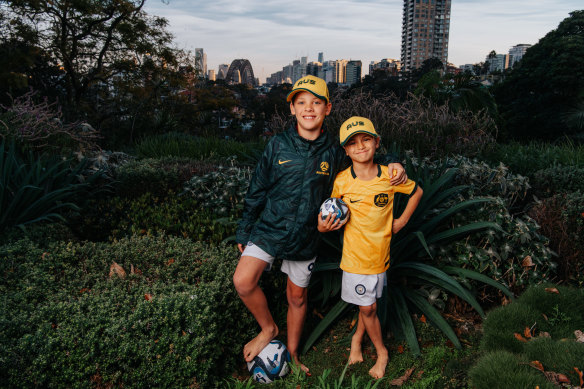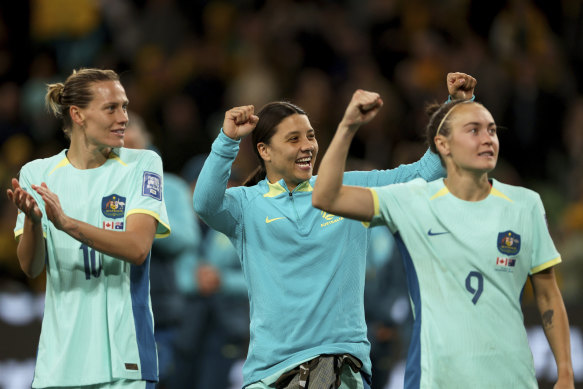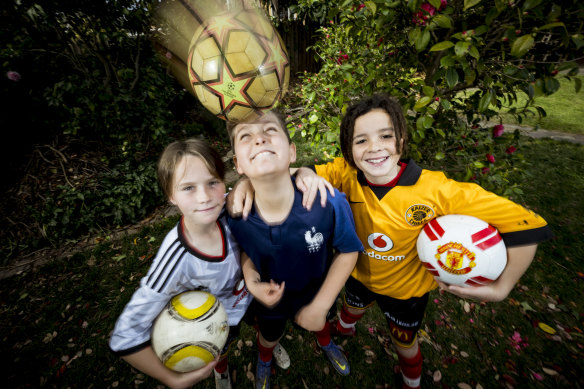Save articles for later
Add articles to your saved list and come back to them any time.
When sports fanatics Spencer and Beau Brice were told they were going to watch a TV show about women’s soccer, the brothers were not impressed.
“They basically told me: oh, we don’t watch girl sport,” their mother, Maddie Marsh, recalled. And I said: “Ah, yes we do.”
Kitted out in their Matildas gear – for his seventh birthday, the jersey was top of Beau’s wishlist – and glued to every Australian match of the Women’s World Cup, the boys have had quite the turnaround from being forced to watch the team’s Disney+ documentary earlier this year.
Spencer and Beau Brice from Sydney’s Neutral Bay have become big Matildas fans.Credit: James Brickwood
Asked for their favourite player, they answer in unison: “Sam Kerr.” But 10-year-old Spencer can’t stop there: “Katrina Gorry, Ellie Carpenter, Mary Fowler.” Kicking a ball around the backyard of his family’s home in Sydney’s Neutral Bay, Beau celebrates as the ball hits the side fence: “A goal for [Matildas winger Hayley] Raso!”
While ads playing during Women’s World Cup games focus on the role the sport can play in inspiring young girls, the national team’s fan base has grown to become exactly that: national. The Matildas will have the country on their side as they take on Denmark in the do-or-die round of 16 match on from 8.30pm Monday.
Rebel Sport managing director Gary Williams said sales of Matildas jerseys this year had exceeded Socceroos jersey sales for last year’s Men’s World Cup campaign.
Pubs have found the games to be big attractions. At The Clock in Sydney’s Surry Hills, 500-odd patrons packed in on Monday night to watch the Matildas’ final group game.
Staff at The Clock, which gives a free margarita to fans after the Matildas’ first goal of the match, said the number of punters there for the game was similar to what they would see for State of Origin or the NRL grand final.
A couple of suburbs over, Joel Heffernan, manager of The Toxteth in Glebe, said their numbers for Matildas games were also similar to, if not more than, what they would see for State of Origin.
“We have to have every screen on. Even for the Bledisloe or the Ashes we don’t have enough people interested to have every screen on,” he said.
In Melbourne, the Empress Hotel in Fitzroy North is pouring a Golden Boot Draught from Stomping Ground brewery, created in honour of the Matildas.
Emily van Egmond, Sam Kerr and Caitlin Foord celebrate the win against Canada.Credit: AP
Gen Dohrmann, president of Women Sport Australia, said the Matildas’ widespread popularity was a wake-up call to those who think women’s sport exists solely to inspire little girls or appease a female audience.
“That has definitely been a way that people have thought about women’s sport previously: that the audience is going to be largely female,” she said.
“But what we are seeing now is teams, like the Matildas and like the Australian Women’s Cricket team, that have transcended to make themselves just as popular if not more popular as the men’s sides.
“You’ve got men at the coffee shop talking about how good the Matildas were last night, and I don’t think you would have had that a decade ago.”
Describing this year’s FIFA Women’s World Cup as a tipping point for the nation’s women athletes, Dohrmann said the shift could be traced back to the success of women’s domestic sports brands, such as the W League and the WBBL.
“There has been a big push around developing those female sporting personalities: for people to know who the Sam Kerrs and Ellyse Perrys are,” she said.
Indeed, after their parents saw their enthusiasm for the Matildas, the Brice brothers attended their first NRLW game last week.
Dohrmann said parents may see encouraging boys to idolise women’s sports stars as a “safer bet” amid recurring incidents of bad behaviour from male players in the NRL, AFL and rugby union.
“Female athletes are always so humble about the opportunities they have been given because they’re never expected them … they’ll go there and they’ll sign every autograph because they want to inspire and they remember not having anyone to look up to,” she said.
“But in another 10 years hopefully our female athletes are used to this level of excitement and coverage and fervour.”
UTS sports business academic Lewis Whales said the Women’s World Cup was probably the biggest sports event Australia has hosted since the Sydney 2000 Olympics.
Young soccer fans Orlando Rizzi (blue shirt), 11, Preston Shingange (yellow shirt), 12, and Obi McGregor, 12 from Preston have been keenly following the Matilda’s success.Credit: Chris Hopkins
“The longer term will be the real challenge,” he said, adding it would be necessary for both governments and associations to work together to hold on to the enthusiasm whipped up by a home-soil international tournament.
“The legacy impacts are really going to be determined by how well those organisations can convert what exists now.”
Soccer fanatic Orlando Rizzi, 11, from Preston in Melbourne had watched some Matildas games before, but says the World Cup really got his attention.
As an Arsenal fan, he likes Caitlin Foord, who plays for the club’s WSL side, although his favourite player is probably the Player of the Match from the Australia’s victory over Canada last week, Raso: “She can create options out of nothing,” he said.
Rizzi said he and his friends, who have played soccer together for three years, were dissecting each match, and discussing key plays in the playground. As for the gender of the players? That hasn’t come up.
“It’s not really men’s football or women’s football: I think it’s just good football,” he said.
The Morning Edition newsletter is our guide to the day’s most important and interesting stories, analysis and insights. Sign up here.
Most Viewed in National
From our partners
Source: Read Full Article








